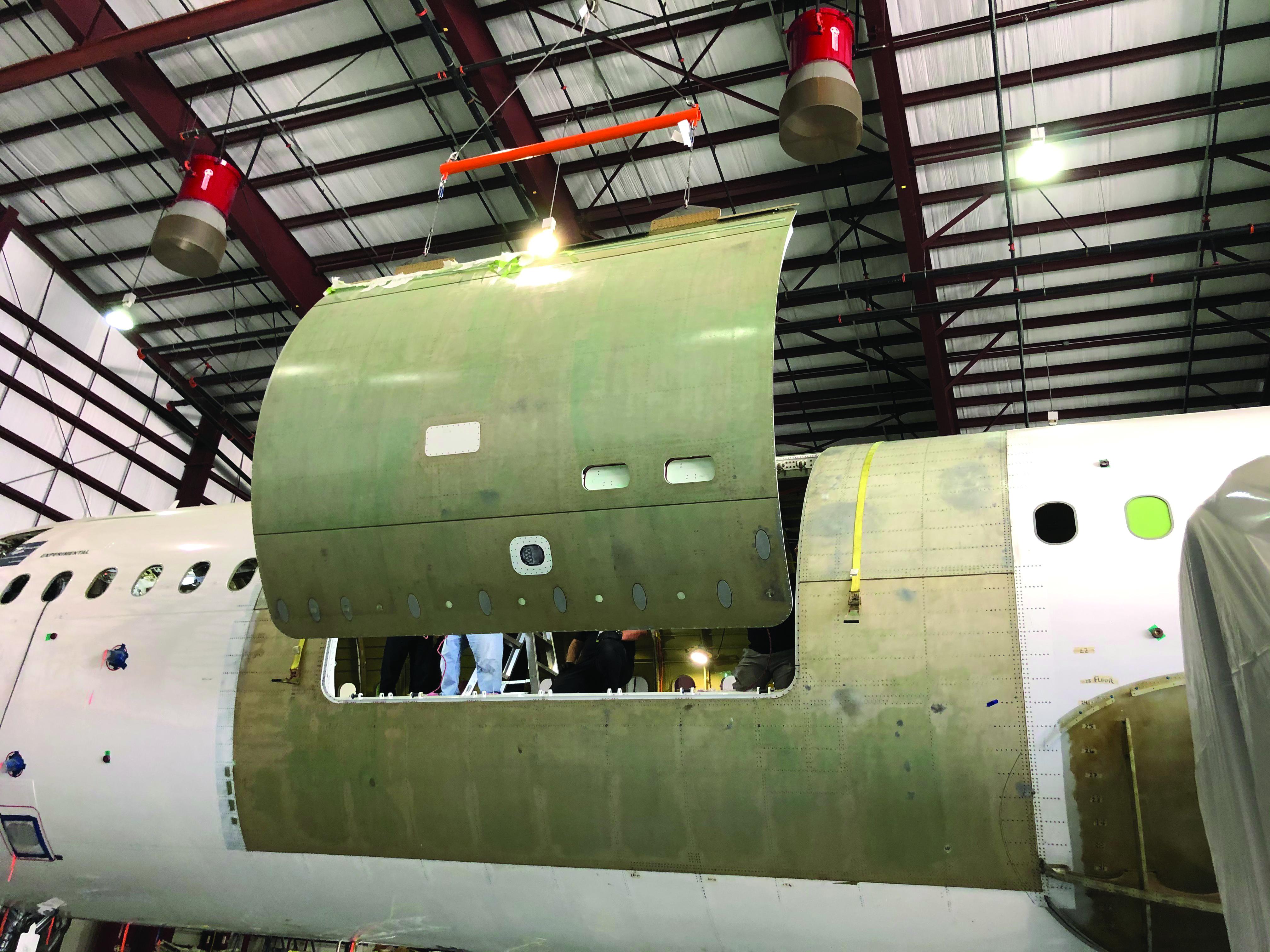Aircraft Cargo Door, Handling System Designs Seek Greater Efficiency

With a growing market for passenger-to-freighter conversions, the major airframe components directly involved with main deck handling of bulk freight and cargo contained within unit load devices are seeing more attention. Vendors of cargo-handling systems have responded and are offering a new generation of equipment for greater operational and maintenance efficiency as well as weight savings.
A few significant trends are gaining traction. One is main deck cargo-door electrically sequenced operations, says Brian McCarthy, vice president of marketing and sales for Mammoth Freighters, which performs passenger-to-freighter (PTF) conversions on Boeing 777-200LRs and 777-300ERs. The first is due for delivery by the end of 2023.
“This has resulted in a reduction in the use of older hydraulic valves in favor of solenoid-directed hydraulic pressure,” he says, adding that door safety and proximity switches are trending away from mechanical activation, and are now using digital or laser-type sensors. This, he says, has reduced the number of moving parts and eliminated items more prone to failure. He also says door latches, locks and position switches are components targeted by the new designs.

At the same time, composites are making headway. “In general, for new-build aircraft—and across all door types—the trend is to go to more composite structure design with fail-safe, efficient mechanisms,” says Stephane Dion, vice president of engineering and technology at Collins Aerospace. “On the door structure alone, composites can enable up to a 40% reduction in weight as compared to a metallic equivalent. A common thread across all doors also includes the use of additive manufacturing for quicker development of parts and for weight-optimized complex mechanism components.”
Dion says modern design approaches, composite materials and additive manufacturing allow more efficient integrated architectures with fewer parts and fasteners will be designed. “As an industry, corrosion is a topic that is well understood, and design practices are in place to minimize any [unintended] effects,” he adds.
Suppliers confirm the importance of these trends. For instance, the latest generation of freighters, including the Boeing 747 and 777 and the Airbus A330, incorporate powered systems driving the rollers during loading and unloading via a man-machine controller. “Powered drive systems allow faster, more efficient loading with reduced manpower,” says Ed Dugic, vice president of sales and marketing for Ancra International, a major supplier of main deck cargo-loading systems.
Weight savings remain a major concern for operators. Dugic says the industry has made some progress, pointing out that older-generation 747 freighters required extensive wiring to enable communication between the control systems and the power drives. “Today, the discrete wiring between the control system and the power drive units uses network communication technology, which has reduced the number of wire harnesses, resulting in a weight saving,” he notes. That technology has been applied to later-generation 747s, 777s and, more recently, the A330 PTF conversions by EFW in Germany.
Dugic adds that the industry is always looking to make cargo restraints and guidance systems lighter while maintaining their structural integrity.

At this year’s Farnborough International Airshow, Curtiss-Wright announced a main-deck cargo door electrical actuation system that is being custom-built for the Airbus A350F.
“To our knowledge, the A350F will be the first time electric actuation has been specified for a main-deck cargo door,” says Oliver Green, director of business development for the Curtiss-Wright actuation division. “Using high-voltage, direct current reduces the weight of the electric motors and the cable from the controllers to the actuators, themselves.” He also notes that the actuation system is digital, enabling its maintenance status to be monitored by the aircraft’s onboard diagnostics.
Green says the electrical cargo-door actuation design is more reliable than conventional hydraulic actuation systems and requires no scheduled maintenance. “That is accomplished by not having to use parts—such as O-rings—which do not require maintenance but still mandate change-outs at specific intervals,” he says.
In addition, electrical cargo-door software can be tuned during the system integration, Green notes, which allows adjustment of the door’s performance to customer requirements.
Stressing that the technology is mature, Green says Curtiss-Wright sees application of its main deck cargo-door electric actuator to other aircraft. “It would be offered on a customized basis, mainly to meet customer specifications to minimize weight,” he says. “In fact, we are already in discussions with people—other than Airbus—with respect to their freighter programs.”
Airbus A350F Chief Engineer Joel Rocker confirms that the aircraft’s main deck cargo door will be fully electrically actuated—as well as electrically latched and locked—which he says provides more efficient, reliable performance.
“The cargo doors for both the lower deck and main deck—including the closing system—are made of carbon fiber and titanium, which are basically corrosion-free materials in our operating environment,” Rocker says. “The composite design enables integrated design combining several parts and/or functions. Combined with titanium material, it provides a corrosion-free structure, reducing by 40% the maintenance costs compared to standard aluminum design.” He adds that the average time between overhauls of the door is aligned with the current A350 maintenance schedule, typically at intervals of six and 12 years.

Gary Warner, president of PTF conversions specialist Precision Aircraft Solutions, says the company developed a hybrid electric/hydraulic actuation system for the main deck cargo door for its A321-200 PCF project, carried out by 321 Precision Conversions—a joint venture of Precision Aircraft Solutions and Air Transport Services Group—delivered its first PTF conversion of an Airbus A321 last year to Latvia-based SmartLynx. The technology developed is 321 Precision Conversions’ intellectual property.
“We concluded that a hybrid electric/hydraulic door would provide the level of reliability we were looking for, especially for a door that will open and close multiple times per day in a typical freighter operation,” Warner says. “There are fewer parts required compared to pure hydraulic doors, and if the door will not open or close, there are special procedures for the operator to follow that are easier than pure electric or hydraulic to activate it.”
For the cargo-loading system, Warner stresses that reliability and simplicity are key. “You want the fewest possible parts,” he says. “From our perspective, this is the trend with cargo handling systems on narrow-bodied aircraft. In fact, that actually makes it easier for the cargo handlers to load the aircraft and contributes to reliability.”
While Precision Aircraft Solutions fabricated the cargo door in-house, the cargo-loading system and the floor panels came from Telair in Germany.
A Telair representative says the aircraft cargo-handling system supplier is incorporating quickly convertible loading—away from mechanical to powered—as well as bulk-system loading in the lower deck, along with built-in test equipment to support failure identification. “Future features we are pursuing include remote maintenance capability, [unit load devices] tracking within the cargo-loading system and control system simplification.”
Among Telair’s innovations is its Modular Cargo Loading System (ModCar) for the A320 family, which provides the flexibility to convert lower- deck cargo holds from bulk-loading to containerized cargo operations during an overnight maintenance check. ModCar, which Telair says is the only system of its kind on the market, consists of individual pre-assembled/configured modules which contain all the cargo operation-related hardware. The modules have roughly the same footprint as today’s AKH-type (LD3-45W) A320-series container and can be easily handled by two mechanics during the reconfiguration process.
Sergey Starkov, technical director of Vallair, takes a more conservative view of recent cargo system trends, particularly those involving converted freighters. “For converted freighters like 737 Classics and A321s, the design has remained quite stable over the years,” he says. “Some supplemental type certificate houses tend to reduce the number of components, for example, using only one actuator instead of two, while others are introducing new components and improving operational logistics—via software—to increase the level of safety and dispatch reliability. At the same time, others are introducing new components to improve safety levels and dispatch reliability.”
Asked about composites, Starkov says that for classic PTF conversion types, metal appears to provide the required level of strength, acceptable weight and cost and keeps the production process simple. “If composite doors could provide significant weight savings while remaining cost-efficient and friendly to [adjoining] aluminum skins, then there is certainly a possibility to see composite doors in the near future,” he says. “The A350F may be the first to have such a door and pave a road there. A [Boeing] 787 conversion study could also provide interesting results.”






